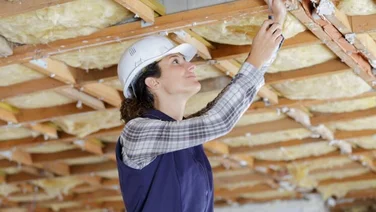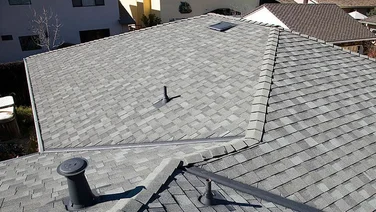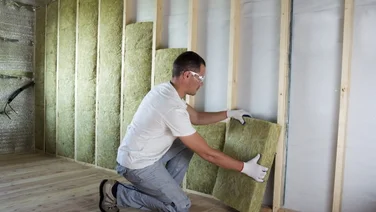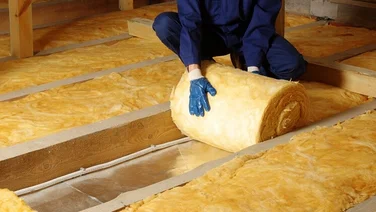- Installing insulation in your loft can cut your energy bills and increase the value of your property by 16%
- There are four main types of loft insulation
- Loft installation generally takes less than a day to install
- Loft insulation should pay itself off within two years, through savings on bills

Effective loft insulation can save you a lot of money on your household energy bills.
Regardless of what type you choose, a bonus is that loft insulation generally pays for itself.
Here, we explain the main factors involved and what you need to consider.
If you’re interested in insulating your loft, just enter a few details here and we will put you in touch with expert installers who will be able to provide more detailed advice.
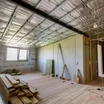
Get free loft insulation quotes
Answer a few quick questions, and our trusted installers will send you bespoke insulation quotes – for free.
How much does loft insulation cost?
| House size | Blanket insulation | Loose fill insulation | Sheet insulation | Labour costs | Time required |
|---|---|---|---|---|---|
Terraced | £125–£160 | £180–£225 | £250–£310 | £250-£450 per day | 4-5 hours |
Semi-detached | £200–£250 | £290–£360 | £400–£500 | £250-£450 per day | 4-5 hours |
Detached | £300–£375 | £430–£540 | £600–£750 | £250-£450 per day | 6-8 hours |
Bungalow | £375–£420 | £700–£730 | £1,000–£1,200 | £250-£450 per day | 6-8 hours |
The cost of installing loft insulation can vary extensively, depending on the size of your house and the type of loft insulation you install.
There are four types of materials you can use, which can impact insulation costs dramatically. The other main factor is the amount of roof space you have in the loft.
The average cost of basic insulation is £15 per m2, with more premium types costing up to £55 per m2. Average labour cost is between £250 and £450 per day, but some insulation tyupes may need specialist equipment which could increase the overall cost.
If you’re looking for a really cheap but effective form of insulation, pipe insulation is a great option. Our guide on pipe insulation covers everything you’ll need to know.
Are there any government grants for loft insulation?
The main government grant for loft insulation is the Energy Company Obligation (ECO) scheme. This requires energy suppliers to help customers improve the energy efficiency of their homes. Depending on your personal circumstances, this scheme could provide up to 100% of the costs for purchase and installation.
However, in order to be eligible for this scheme, you must be in receipt of certain benefits, such as Pension Credit, Working Tax Credit, Income Support or Jobseeker’s Allowance and have an annual income of less than £31,000.
Applicants apply for the scheme through their installer.
The second best option is the Warm Homes Local Grant, which is designed to help cover the cost of upgrades for households across England. The grant covers various energy efficiency measures, including solar water heaters, particularly for homes off the gas grid.
Another great access to funds before being scrapped was the Home Upgrade Grant (HUG). This government-backed scheme was designed to help cover up to 60% of the costs of insulation, including loft insulation. The scheme ran until March 2025 and is not accepting new applications.
Want to explore more insulation grants? Check out our page on Government Grants for Insulation.
What affects the cost of loft insulation?
- The two main factors affecting the cost of loft insulation are the type of insulation used, and the amount of roof space to cover
- Ease of access can increase the cost of labour
- Removing existing loft insulation
- Moving electrical wiring
- Whether a loft hatch or ladder needs to be installed
- If you want to use your loft for storage, you’ll need to lay boards on top of the joists – these boards will need to have a built-in insulation layer
- You’ll also need to insulate any pipes going through your loft, as loft insulation makes the loft space cold (keeping the heat in your house below instead)
How much money will loft insulation save me?
Insulating your loft will pay for itself in a little under five years for a typical semi-detached three-bedroom home. The Energy Saving Trust estimates that loft insulation can save a home like this roughly £200 a year on energy bills, assuming the loft was previously uninsulated.
These figures are based on fuel prices as of July 2024.
You can find out more about savings on our Home Insulation Costs page.

Every type of insulation explained
There are four main types of insulation available for lofts:
- Blanket insulation – this is the easiest type of loft insulation to install and is most suitable for DIY projects. You can usually buy rolls costing just £20 each and you can simply roll them out over the roof joists.
- Loose-fill insulation – you can use loose-fill insulation to fill in the small gaps between the roof joists. It’s an effective way of adding to existing insulation, but the material can come loose in draughty lofts and it requires protective clothing to install.
- Sheet insulation – if insulating the underside of your roof, you’ll use sheet insulation which comes in the form of firm boards. They are made from either synthetic or natural materials, and are an effective way to insulate your loft.
- Multifoil insulation – this is a type of insulation material made up of multiple layers of foil and wadding, which creates a barrier to stop heat loss. The foil’s reflective properties help to reflect radiant heat back into your home.
How long does loft insulation take?
Most loft insulation takes less than a day to install, especially when installed by a professional installation company. This might take longer if you opt for a DIY insulation project – but we wouldn’t advise going down that route.
Loft insulation needs replacing when it is in poor condition or is in the form of a dangerous material, such as asbestos.
How do I get started?
- Check to see if you already have loft insulation, what material is and what condition it is in. If it is asbestos, it will have to be removed, and that will add to the cost.
- If it is not asbestos and is in good condition, it might be a good idea to just top it up (for example with loose fill insulation), which will save on the cost.
- Check your roof space for draughts. If the loft is draughty, this will affect your choice of insulation type.
- Think your home could benefit from an extra layer of warmth? Pop your details here and we will put you in touch with expert installers.
Summary
- Effective loft insulation can save on household energy bills, and it should pay for itself within two years.
- The two biggest factors are the type of loft installation and amount of roof to cover.
- Average labour costs are between £250 to £450 per day.
- The main government grant for loft installation is the ECO4 scheme.
- There’s also the Warm Homes Local Grant, which helps with the cost of various energy efficiency measures, including solar water heaters, particularly for homes off the gas grid.


